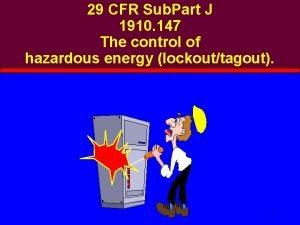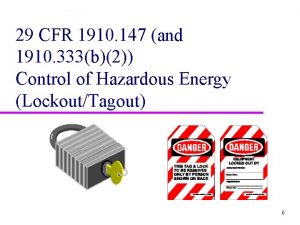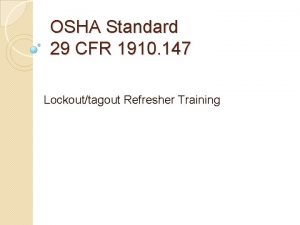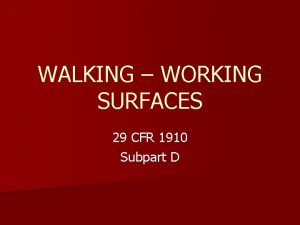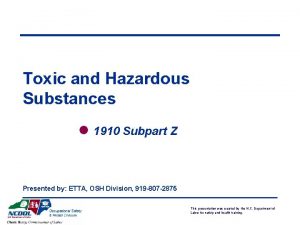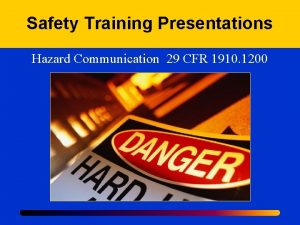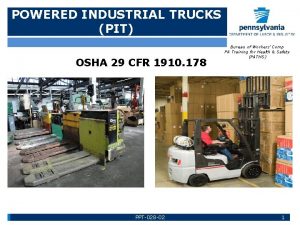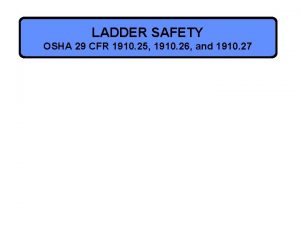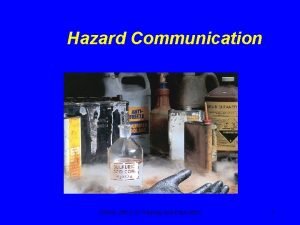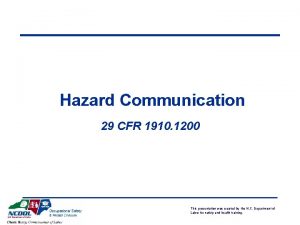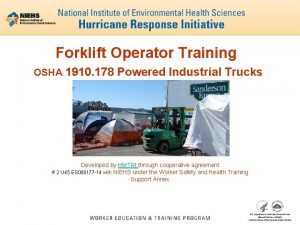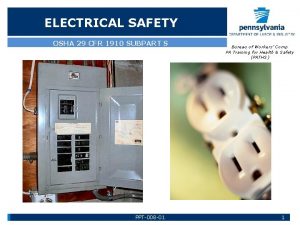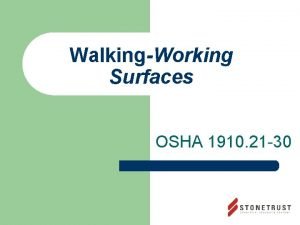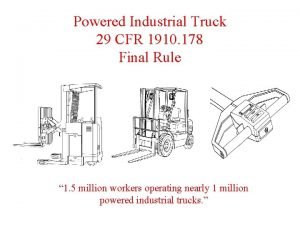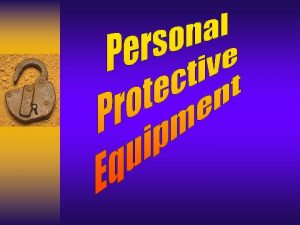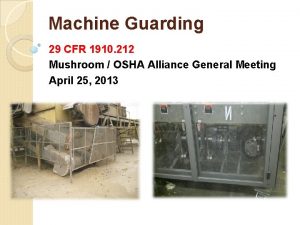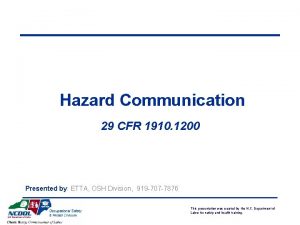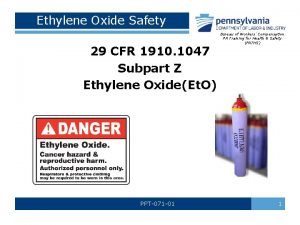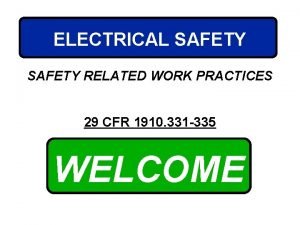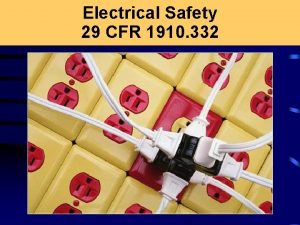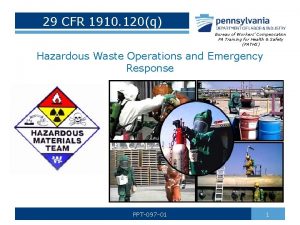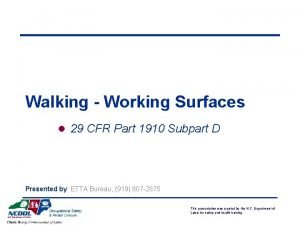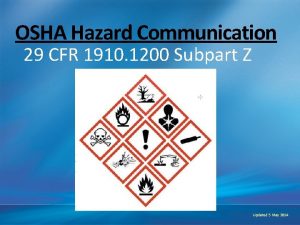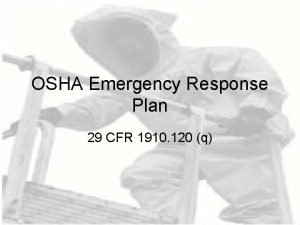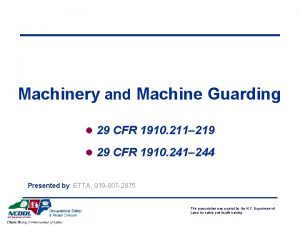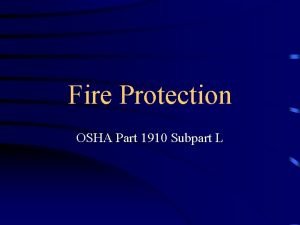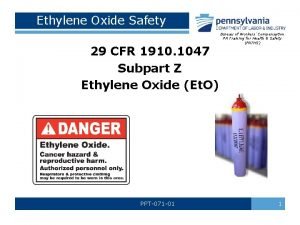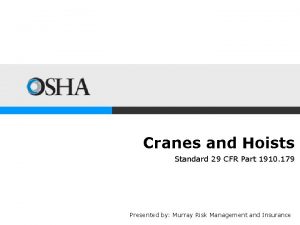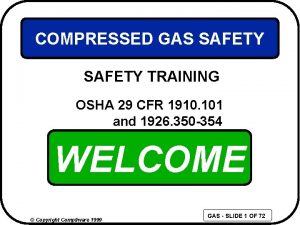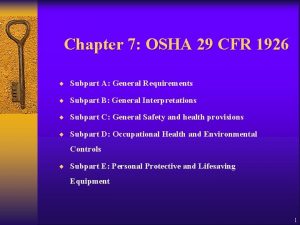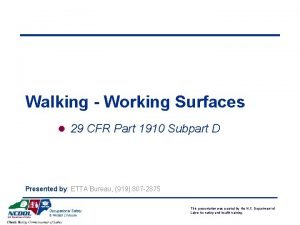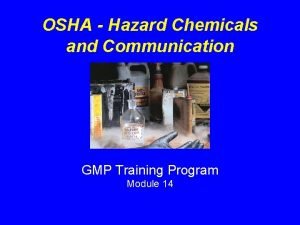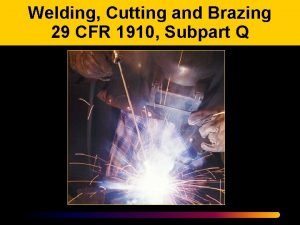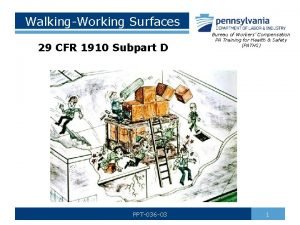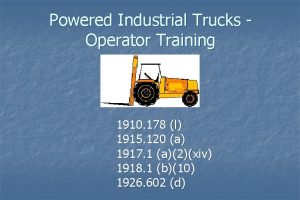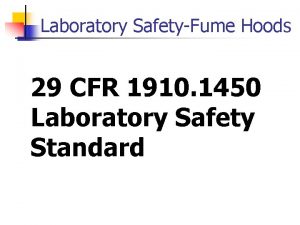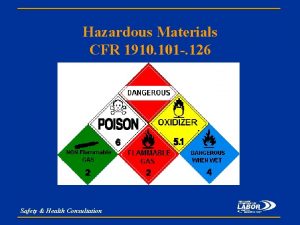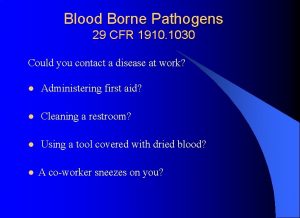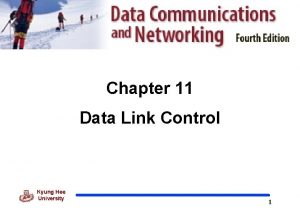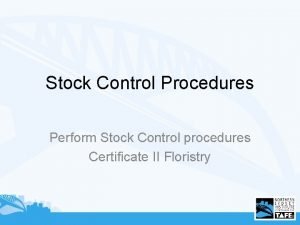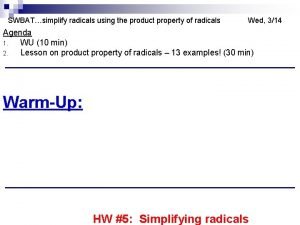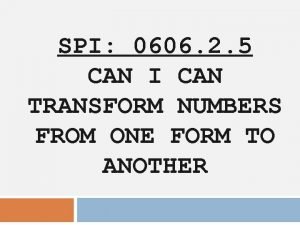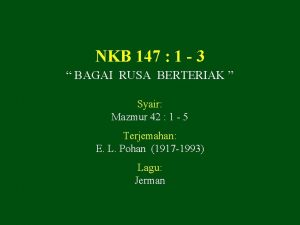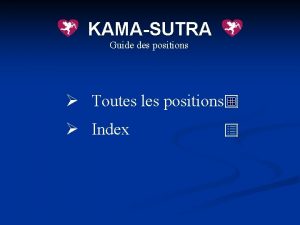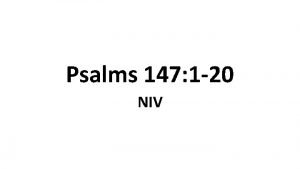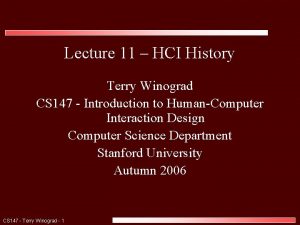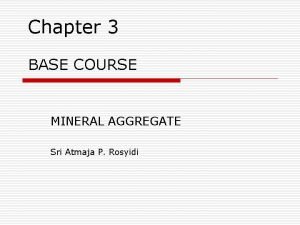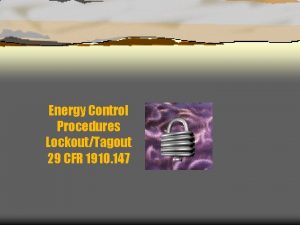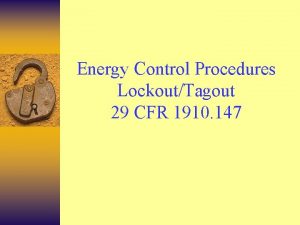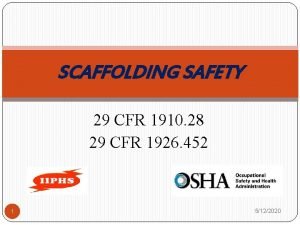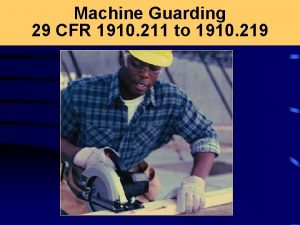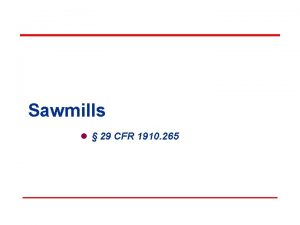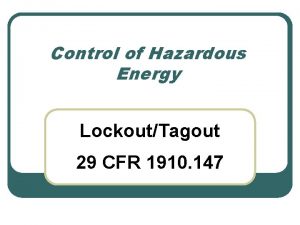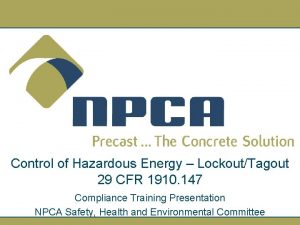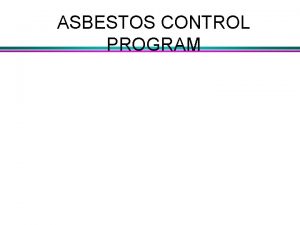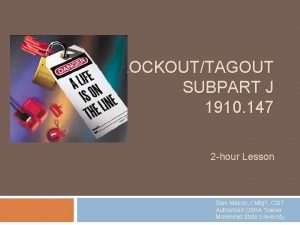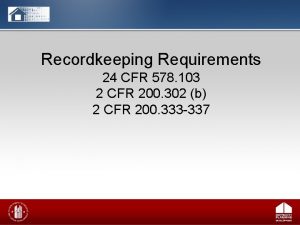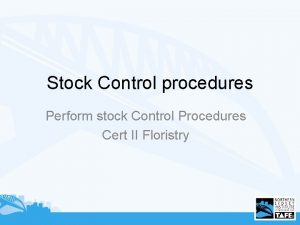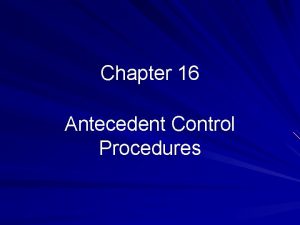ENERGY CONTROL PROCEDURES LOCKOUTGOUT 29 CFR 1910 147




































































- Slides: 68

ENERGY CONTROL PROCEDURES LOCKOUT/GOUT 29 CFR 1910. 147 HAZARDOUS ENERGY CONTROL

Objectives • After this session, the participant should be able to: o Discuss the importance of LOTO o List the elements of a basic LOTO program o Identify hazards associated with poor execution of LOTO o Discuss the procedures that are necessary to control hazardous energy 2

INTRODUCTORY LOTO QUIZ • What is the purpose • What are the of LOTO? components of a LOTO program? • When does LOTO apply? • How often do you have to audit LOTO • What are the primary procedures? sources of energy in the work environment? 3

Most Frequently Cited Hazards 4

Most Frequently Cited Hazards Continued 5

What Causes Injuries? • Based on a Bureau of Labor Statistics (BLS) study: o 80% fail to turn off the equipment o 10% activated by someone else o 5% failed to control potential energy o 5% failed to verify 6

What is covered? • Servicing and maintenance • Normal production operations where: o Employees by-pass guard(s) o Employees place any part of their body in a hazardous area o When you are training it is important to cover the relationship between Subpart OMachine Guarding and Lockout Tagout!! 7

What is not covered? • Construction, agriculture, and maritime • Normal production operations o subpart O • Cord-and-plug under the control of employee o written procedure still required • Exposure to electrical conductors o subpart S and electrical safety-related work practices 8

Should this be locked out? 9

What about this equipment? 10

Energy types • Electrical • Mechanical • Hydraulic • Pneumatic • Chemical • Thermal • Other 11

Lockout vs. Tagout • If capable of being locked out: o Prefer lockout o Tags allowed, if employer can demonstrate FULL EMPLOYEE PROTECTION • Machine Modifications o If you alter a machine you must make the machine capable of accepting a lock. 12

Full employee protection? • Tags attached at the same location as locks • Full compliance with all tagout provisions in 29 CFR 1910. 147 • Additional means when necessary o e. g. , removal of a valve handle 13

Definitions • Affected employee • Authorized employee • Capable of being locked out • Energy isolating device • Servicing and/or maintenance 14

Servicing and maintenance includes: • Setting up • Adjusting • Inspecting • Modifying • Installing 15

Lockout/tagout requirements • Written program which includes specific written procedures • Training of employees (not just maintenance!) • Periodic review of procedures 16

Written Lockout/Tagout Procedure (Equipment Specific Procedures) • Clearly and specifically outline o Scope o Purpose o Authorization o Rules, techniques for control of energy 17

Lockout procedure (cont. ) • Clearly and specifically outline: o Means to enforce compliance including: § Intended use of procedure § Specific procedural steps § Specific testing requirements 18

Documentation exceptions: 1. 2. 3. 4. 5. 6. 7. Machine has no potential for stored energy Machine has a single energy source Isolation of that source will completely de-energize Machine is isolated during maintenance Machine must be capable of being locked out during maintenance The device is under the control of the employee Servicing or maintenance does not create hazards for other employees 8. The employer has had no accidents involving activation or reenergization during servicing or maintenance • Note: must meet all 8 items before exception applies. 19

Energy control procedure • • Notification of employees Preparation for shutdown Machine or equipment isolation Lockout/tagout device application Stored energy Verification of isolation Release from lockout/tagout 20

Equipment Specific Procedures 21

Lockout procedure – Step 1 • NOTIFICATION OF EMPLOYEES o Before controls are applied, and again before they are removed 22

Lockout procedure – Step 2 • PREPARATION FOR SHUTDOWN o Knowledge of the type and magnitude of energy and methods to control energy § Caution: Employees that operate circuit breakers, disconnects, or other electrical devices must be trained and qualified. 23

Precautions of Operating Electrical Disconnects/Circuit Breakers • Employees should be very careful, when initially operating circuit breakers and disconnects. • The equipment may be allowed to be used in the normal operation mode, if all conditions are met: Covers/doors are in place The equipment is maintained The equipment is properly installed The equipment is inspected to ensure it meets the installation codes o There is no impending sign of failure o o 24

Electrical Disconnects and Circuit Breakers • If the equipment does meet all six of the criterions, as mentioned in the previous slide additional precautions must be taken (outlined in 2018 NFPA 70 E): o Hazard Risk Assessment must be performed to determine if an arc flash hazard exists o The results of the Hazard Risk Assessment will determine what controls to put in place using the hierarchy of controls § PPE is the last resort o If PPE has to be used, determine the PPE Category (1 -4) and arc flash/shock boundaries o Refer to PPE matrix to determine what kind of PPE has to used for the task • Note: OSHA does not mention any of this in the LOTO standard, but these actions are vital to protect the workers. 25

Lockout procedure – Step 3 • MACHINE OR EQUIPMENT SHUTDOWN o Orderly shutdown to avoid increased hazard 26

Lockout procedure – Step 4 • MACHINE OR EQUIPMENT ISOLATION o All energy isolation devices located and operated to isolate machine 27

Line breaking: • Means the intentional opening of a pipe, line, or duct that is or has been carrying flammable, corrosive, or toxic material, an inert gas, or any fluid at a volume, pressure, or temperature capable of causing injury 28

Line blanking or blinding: • Means the absolute closure of a pipe, line, or duct by fastening of a solid plate that completely covers the bore and that is capable of withstanding the maximum pressure of the pipe, line, or duct with no leakage beyond the plate. 29

Double block and bleed: • Means the closure of a line, duct, or pipe by closing and locking or tagging two inline valves and by opening and locking or tagging a drain or vent valve in the line between the two closed valves. 30

Lockout procedure – Step 5 • LOCKOUT OR TAGOUT DEVICE APPLICATION o Affixed by authorized employee holding energy isolating device in the safe or off position 31

Energy Isolation 32

Lockout procedure – Step 6 • STORED ENERGY o Relieve all stored energy and continue to verify if there is a chance of re-accumulation 33

Stored energy examples • Batteries and capacitors • Pressure differential o Hydraulic o Pneumatic o Vacuum • Springs • Gravity 34

Lockout procedure – Step 7 • VERIFICATION OF ISOLATION o Prior to servicing or maintenance, authorized employee must verify machine has been de-energized § Press buttons, operate controls, and use a volt meter (if electrical conductors are involved) § Caution: Employees that use volt meters must be trained and qualified (the use of volt is considered to be live electrical workemployees must implement the use of electrical safe work practices until verification is completed and they confirm the absence of voltage (PPE may be taken off once the verification of isolation has been completed). 35

Lockout procedure – Step 8 • RELEASE FROM LOCKOUT OR TAGOUT o Inspect work area to ensure removal of nonessentials o Employees safely positioned and notified o Lockout/tagout removal § by employee who applied 36

Lock/tag removal if authorized employee is not available? • Verify that authorized employee is not at facility • Make reasonable efforts to inform him or her • Ensure that he/she knows of removal upon re-entering • MUST INCLUDE THIS PROCEDURE IN WRITTEN PROGRAM 37

Hardware requirements • Durable • Standardized • Substantial • Identifiable 38

Hardware must be: • Provided by the employer • Singularly identified • Only devices used for control • Not used for other purposes 39

Hardware must be (cont. ): • Durable – be able to withstand environment • Standardized – color, size, etc. o Tags : print and format • Substantial – no accidental removal o Tag attachment means: § § Withstand at least 50 pounds of force Not re-usable Self locking Attachable by hand 40

Durable… 41

More Hardware Requirements: • Identifiable – identify the employee who applied o Tags must include legend such as DO NOT START 42

Locks, Hasps, and Tags 43

Locked Out Tagged Out of Service 44

LOTO On Pipes? 45

Pipes Locked Out? ? 46

Lockout Valves 47

Improper Lockout/Tagout Equipment 48

Lockout Hasp Improved hasp is harder to remove! 49

Lockout Hardware 50

Locked Out Valve This valve only moves in one direction (down) and is chained and locked to prevent movement in that direction! 51

Periodic Inspection • Performed at least annually • Lockout – include review with authorized employees • Tagout – include review with authorized and affected employees • Certification record kept: o Identify machine or equipment o Date of inspection o Employees performing and included in inspection 52

Training and re-training • Authorized employees o o Recognition of hazardous energy Type and magnitude of hazardous energy Methods of isolating energy How to verify isolation • Affected – Purpose and use of procedure • Other – Procedure and Prohibition from tampering • Tagout provisions 53

Re-training is required when: • Change in job assignment • Change in machine or process • Change in lockout/tagout procedure • Inadequacies revealed in periodic review 54

Training certification • Certify that the training has been conducted and kept up to date: o Employee names o Date(s) of training 55

Other requirements • Contractors? • Personnel or shift changes? 56

Testing or positioning machines • Clear the machine of tools and materials • Remove employees from the area • Remove lockout/tagout devices • Energize and proceed with testing/positioning • De-energize and re-apply energy control measures 57

Group lockout • Personal lock or tag (usually) • Lockbox or master tag system with principal authorized employee • “Shall utilize a procedure which affords a level of protection equivalent to that provided by the implementation of a personal lockout or tagout device” 58

Group Lockout Examples Each exposed employee must be provided the same level of protection…Each person must be protected by their own lock! 59

Minor Servicing Exemption • Activities which are routine, repetitive, and integral to the use of the equipment for production are not covered by this standard if alternative measures provide effective protection. • Activity must be conducted during normal production operations • Activity must be routine (regular course of procedure in accordance with established practices), repetitive (regularly repeated as part of production), and integral (essential to the production process). 61

OSHA’s E-Tool 62

LOTO Tech Guide Lockout/ Tagout Tech Guide available @ www. oshainfo. gatech. edu 63

SUMMARY • Written program including written procedures for each machine • Training of employees • Periodic review of program • ENFORCEMENT 64

Exercise: Periodic Inspections • You have been hired as a consultant to assist XYZ company to implement procedures for periodic inspections. You notice the following issues: • There are no procedures on periodic inspections • The safety manager, who is not an authorized employee, occasionally has interaction with workers while they implementing a lock out tag out • Meetings are held to discuss the machine specific procedure • Some of the employees frequently have to consult with other workers on the execution of the procedures. 65

Exercise: Periodic Inspections Continued • Based on the facts on the previous slide, what would you do to assist the company in developing and implementing a periodic inspection system. Address the following: o What elements need to be included in the system? o How would you conduct a periodic inspection? o Who needs to be involved in the periodic inspections? o What are the best practices to ensure that all machine specific procedures get evaluated? 66

Exercise: Machine Specific Procedures • You are assigned to review the machine specific procedures, so you need to take a look at the procedures in the next two slides and address the following items: • Is the lockout tagout procedure complete? • What would you do to improve the written procedures? 67

Exercise Continued: Machine Specific Procedures • Steps to Locking out Shredders or Baler • Police area to ensure any safety hazards (Shredders Located in Plant 2 and Baler Located in Processing Area of Plant 1) • Locate Panel Label “A” in Shred Room (Largest Grey Panel at Left in the Corner) • Identify the Appropriate Breaker, Push Breaker Switch to the OFF position (Main Shredder, 2 nd Shredder, Baler) • Use Red LOTO lock on the breaker panel. (Lock Located in the Red and Black Tool Box in EHS’s Office) • Fill out tag and put it on the lock (Tags Located in the Red and Black Tool Box in EHS’s Office) • Inform employees that the machine is LOTO (Personally speak with all employees in the affected area) 68

Exercise: Machine Specific Procedures…. • Steps for Unlocking Shredders or Baler • After machine has been properly serviced by a Certified Tech. , take tag off and give it to the EHS manager. • Take the Red LOTO lock off of breaker panel. (Largest Grey Panel at the Left in the Corner) • Push Breaker switch to the ON Position (Main Shredder, 2 nd Shredder, Baler) • Police area for any safety hazards (Shredders Located in Plant 2 and Baler in the Processing 69 Area of Plant 1)
 1910 147
1910 147 1910 lockout tagout
1910 lockout tagout Osha 1910 lockout tagout
Osha 1910 lockout tagout 1910 subpart h
1910 subpart h Osha z tables
Osha z tables Hazard communication safety training quiz answers
Hazard communication safety training quiz answers Osha 1910 forklift
Osha 1910 forklift Ladder safety
Ladder safety 29 cfr1910.1200
29 cfr1910.1200 Osha cfr 1910 is the standard for______.
Osha cfr 1910 is the standard for______. 29 cfr 1910 section 1200
29 cfr 1910 section 1200 29 cfr 1910 powered industrial trucks
29 cfr 1910 powered industrial trucks Osha subpart s
Osha subpart s Osha 1910 housekeeping
Osha 1910 housekeeping 29cfr1910.178
29cfr1910.178 29 cfr 1910 ppe
29 cfr 1910 ppe Osha conveyor safety 1910
Osha conveyor safety 1910 29 cfr 1910
29 cfr 1910 29 cfr 1910 powered industrial trucks
29 cfr 1910 powered industrial trucks What is ethylene oxide
What is ethylene oxide 29 cfr 1910
29 cfr 1910 29 cfr 1910
29 cfr 1910 29 cfr 1910 120
29 cfr 1910 120 Cfr 1910
Cfr 1910 29 cfr 1910 section 1200
29 cfr 1910 section 1200 Osha emergency response plan
Osha emergency response plan 29 cfr 1910
29 cfr 1910 Osha subpart for fire protection and prevention
Osha subpart for fire protection and prevention 49 cfr 1910
49 cfr 1910 Osha 1910 crane standard
Osha 1910 crane standard 29 cfr 1910 compressed gas cylinder storage
29 cfr 1910 compressed gas cylinder storage 1926 subpart c
1926 subpart c Bloodborne pathogens standard 29 cfr 1910
Bloodborne pathogens standard 29 cfr 1910 29 cfr part 1910
29 cfr part 1910 Osha hazard and ghs training regulation cfr 1910
Osha hazard and ghs training regulation cfr 1910 29 cfr 1910 subpart z
29 cfr 1910 subpart z Osha 1910 subpart d
Osha 1910 subpart d 29 cfr 1910 osha 178
29 cfr 1910 osha 178 1910 ppe
1910 ppe 29 cfr 1910 osha 178
29 cfr 1910 osha 178 29 cfr 1910.
29 cfr 1910. Osha psm 1910
Osha psm 1910 Osha 29cfr1910.134
Osha 29cfr1910.134 29 cfr 1910 1030
29 cfr 1910 1030 Piggybacking in go-back-n arq
Piggybacking in go-back-n arq Situational inducement meaning
Situational inducement meaning Stock control procedures
Stock control procedures Energy energy transfer and general energy analysis
Energy energy transfer and general energy analysis Energy energy transfer and general energy analysis
Energy energy transfer and general energy analysis Addition radicals examples
Addition radicals examples 147% as a fraction
147% as a fraction Sonnet 147 shakespeare
Sonnet 147 shakespeare Sat to iq
Sat to iq Pkj 147
Pkj 147 Nkb 147
Nkb 147 Position 147 kamasutra
Position 147 kamasutra Plan de ordenamiento territorial sincelejo
Plan de ordenamiento territorial sincelejo 734-147-911
734-147-911 Psalm 147 vers 6
Psalm 147 vers 6 Cs 147 stanford
Cs 147 stanford Stanford cs 147
Stanford cs 147 Psalm 147:1 niv
Psalm 147:1 niv Denoporte
Denoporte Cs 147
Cs 147 Cs 147
Cs 147 147 kaça bölünür
147 kaça bölünür Page 175 to kill a mockingbird
Page 175 to kill a mockingbird Mineral aggregate definition
Mineral aggregate definition 147 mhz
147 mhz
